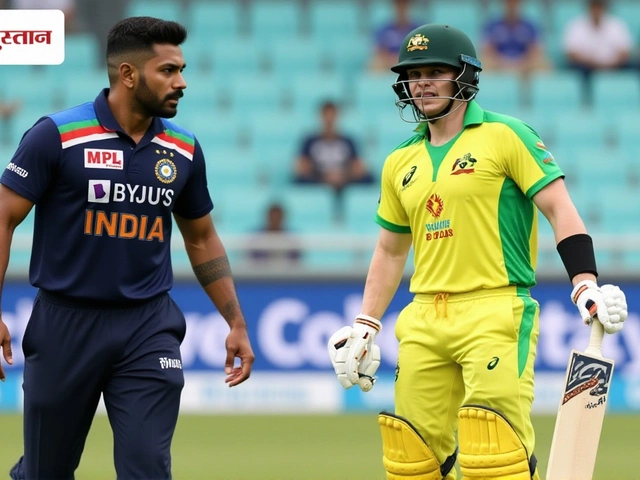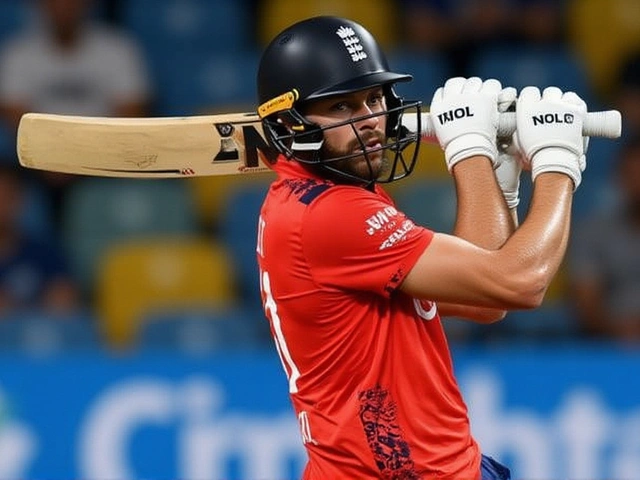
When Hardik Pandya, India’s flamboyant all‑rounder, was handed the Player of the Series award for the 2017 ODI showdown, cricket fans around the world took notice. The five‑match series, part of the Australia tour of IndiaIndia, ran from September 12 to October 13, 2017, and ended with India clinching a convincing 4‑1 victory.
Background: A Rivalry Renewed
India and Australia have long battled for supremacy in the limited‑overs arena. Prior to the 2017 series, Australia had won the previous three ODIs on Indian soil, while India’s last win in Australia dated back to 2015. The tour was therefore billed as a chance for both sides to reset their ODI credentials ahead of the 2019 World Cup.
India entered the series under the captaincy of Virat Kohli, who had already lifted India to the top of the ICC ODI rankings earlier that year. Australia, meanwhile, was led by Steve Smith for the ODIs, with David Warner taking charge of the T20Is.
Series Overview: How the Matches Unfolded
The opening game in Delhi set the tone. India posted 285/6, powered by Rohit Sharma’s 101 and Pandya’s quick‑fire 62 off 45 balls. Australia fell short, bowled out for 260, giving India a 25‑run win.
Australia bounced back in the second ODI in Kanpur, with Aaron Finch’s 98 anchoring a 300/9 total. Yet Pandya’s 83 off 73 balls, coupled with a crucial spell of 3/29, tilted the match in India’s favour by 7 runs.By the time the series reached Kolkata for the third ODI, the scoreboard read 2‑0 to India. Rohit Sharma’s 76 and Kuldeep Yadav’s 3 wickets sealed a 15‑run victory.
The fourth match in Rajkot was nothing short of a thriller. Australia chased down 274, thanks to a partnership between Finch (65) and Glenn Maxwell (57). However, Pandya’s late surge of 46* pushed India over the line, securing a 4‑0 lead.
The dead‑rubber fifth ODI in Mumbai saw India rest several first‑choice bowlers, yet still posted 287/5. Australia managed 229, confirming the series result at 4‑1.
Hardik Pandya’s Breakout Performance
Across the four innings he batted, Pandya scored a remarkable 222 runs off 204 balls, averaging 55.5 with a strike rate of 108.8. His two half‑centuries (83 and 62) featured 13 fours and 12 sixes, underscoring his role as a genuine match‑winner.
“Hardik gave us the spark we needed in the middle order,” said Rohit Sharma, India’s leading run‑scorer for the series with 296 runs. “His ability to finish games quickly changed the complexion of several matches.”
Beyond the bat, Pandya contributed 4 wickets, including a crucial 3/29 spell in Kanpur. His all‑round prowess earned him the series trophy, a first for a young Indian player in a bilateral ODI contest.
Captaincy & Team Strategies
Kohli’s aggressive field placements and willingness to promote Pandya up the order paid dividends. “We wanted to keep the pressure on Australia, and moving Hardik to No 4 gave us that push,” Kohli explained in a post‑match press conference.
Steve Smith, reflecting on his side’s shortcomings, admitted the Australian bowlers struggled with the sub‑continental pitches. “Our pacers didn’t extract enough bounce, and the middle‑overs were a bit sluggish,” Smith said.
On the Australian batting front, Aaron Finch’s 250 runs topped his side’s chart, but the lack of support from the lower order proved costly. Nathan Coulter‑Nile’s 10 wickets were the only bright spot for Australia’s attack.
Impact on Rankings & Future Outlook
The series win catapulted India back to the summit of the ICC ODI Championship, reclaiming the top spot from England with 135 rating points. Australia slipped to fourth, widening the gap to the leaders.
For India, the success reinforced Kohli’s vision of a youth‑heavy lineup, with Pandya, Shubman Gill, and Prithvi Shaw gaining confidence. The Board of Control for Cricket in India (BCCI) hinted that the core group would remain largely intact heading into the 2019 World Cup.
Australia, overseen by Cricket Australia (CA), faced mounting pressure to revamp their middle order and adapt better to spin‑friendly conditions.
What’s Next? Upcoming Challenges for Both Sides
India’s next major assignment was the Asia Cup in September 2018, where they aimed to test the same lineup against Pakistan and Sri Lanka. The experience gained from the Australian tour was expected to be a decisive factor.
Australia, meanwhile, scheduled a home series against England later in 2018, offering a chance to bounce back and close the gap in the ICC rankings before the World Cup.
Key Takeaways
- India won the ODI series 4‑1, clinching the top ICC ranking.
- Hardik Pandya’s 222 runs and 4 wickets earned him Player of the Series.
- Rohit Sharma topped India’s run tally (296); Aaron Finch led Australia with 250.
- Kuldeep Yadav and Nathan Coulter‑Nile were the leading wicket‑takers for their sides.
- The tour highlighted India’s depth and Australia's need for strategic adjustments.
Frequently Asked Questions
How did Hardik Pandya’s performance influence India’s ODI strategy?
Pandya’s ability to score quickly in the middle order allowed India to accelerate in the death overs without losing wickets. His dual role also gave captain Virat Kohli flexibility to rotate bowlers, effectively shortening the opposition’s chase and cementing his place as a front‑line all‑rounder.
What were the main reasons Australia struggled on Indian pitches?
Australian bowlers found the sub‑continental surfaces less responsive to pace, limiting bounce and seam movement. Coupled with a middle order that failed to build partnerships, the lack of spin options against India's strong batting line‑up proved decisive.
Did the series affect the ICC ODI rankings for both teams?
Yes. India reclaimed the No. 1 spot with 135 rating points, overtaking England, while Australia dropped to fourth, widening the points gap to the new leaders. The shift underscored the series’ importance in the lead‑up to the 2019 World Cup.
Which players emerged as future stars after the tour?
Beyond Pandya, the likes of Shubman Gill, who scored 143 runs across the series, and Prithvi Shaw, who displayed aggressive stroke‑play, caught the eye of selectors. Their performances hinted at a strong batting core for India’s upcoming World Cup campaign.
What lessons might Australia take from this defeat?
Australia’s coaching staff highlighted the need for better spin options and adaptable batting techniques for low‑bounce pitches. They plan to incorporate more spin specialists in the squad and run targeted training sessions ahead of the home series against England.



